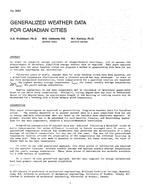Description
In order to simplify energy analysis of single-family dwelllngs, and to assess the effectiveness of retrofits, simplified average weather data is required. This paper analyzes weather data for seven Canadian cities and proposes a method of generalizing this data for use in variable base-degree day calculations.
Thirty-two years of hourly weather data for seven Canadian cities have been analyzed, and a normalized temperature distribution over a 12-month period has been developed. In order to use this normalized distribution, three temperatures for a specified location are required: Tmax, the highest monthly average temperature; Tmin, the lowest monthly average temperature; and Tavrg, the yearly average temperature.
Heating degree-days to any base temperature may be calculated or determined graphically based on the above three temperatures. Similarly, cooling degree-days may also be determined. Based on the degree-days, an approximate length of the heating or cooling season may be determined for a building with a known balance point temperature.
Units: Dual
Citation: ASHRAE Transactions, 1987, vol. 93, pt. 2, Nashville, TN
Product Details
- Published:
- 1987
- Number of Pages:
- 10
- File Size:
- 1 file , 600 KB
- Product Code(s):
- D-NT-87-3054




